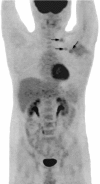Male occult breast cancer with axillary lymph node metastasis as the first manifestation: A case report and literature review
- PMID: 29390502
- PMCID: PMC5758204
- DOI: 10.1097/MD.0000000000009312
Male occult breast cancer with axillary lymph node metastasis as the first manifestation: A case report and literature review
Abstract
Rationale: Occult breast cancer (OBC) is extremely rare in males with neither symptoms in the breast nor abnormalities upon imaging examination.
Patient concerns: This current case report presents a young male patient who was diagnosed with male OBC first manifesting as axillary lymph node metastasis. The physical and imaging examination showed no primary lesions in either breasts or in other organs.
Diagnoses: The pathological results revealed infiltrating ductal carcinoma in the axillary lymph nodes. Immunohistochemical (IHC) staining was negative for estrogen receptor (ER), progesterone receptor (PR), cytokeratin (CK)20 and thyroid transcription factor-1 (TTF-1), positive for CK7, gross cystic disease fluid protein-15 (GCDFP-15), epithelial membrane antigen (EMA) and carcinoembryonic antigen (CEA), and suspicious positive for human epidermal receptor-2 (Her-2). On basis of IHC markers, particularly such as CK7, CK20 and GCDFP-15, and eliminating other malignancies, male OBC was identified in spite of negativity for hormone receptors.
Interventions: The patient underwent left axillary lymph node dissection (ALND) but not mastectomy. After the surgery, the patient subsequently underwent chemotherapy and radiotherapy.
Outcomes: The patient is currently being followed up without any signs of recurrence.
Lessons: Carefully imaging examination and pathological analysis were particularly essential in the diagnosis of male OBC. The guidelines for managing male OBC default to those of female OBC and male breast cancer.
Copyright © 2017 The Authors. Published by Wolters Kluwer Health, Inc. All rights reserved.
Conflict of interest statement
The authors have no conflicts of interest to disclose.
Figures








References
-
- Wang X, Zhao Y, Cao X. Clinical benefits of mastectomy on treatment of occult breast carcinoma presenting axillary metastases. Breast J 2010;16:32–7. - PubMed
-
- Baron PL, Moore MP, Kinne DW, et al. Occult breast cancer presenting with axillary metastases. Updated management. Arch Surg 1990;125:210–4. - PubMed
-
- Fentiman IS, Fourquet A, Hortobagyi GN. Male breast cancer. Lancet 2006;367:595–604. - PubMed
-
- Jemal A, Murray T, Ward E, et al. Cancer statistics, 2005. CA Cancer J Clin 2005;55:10–30. - PubMed
Publication types
MeSH terms
LinkOut - more resources
Full Text Sources
Other Literature Sources
Medical
Research Materials
Miscellaneous

